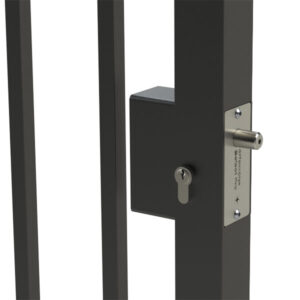Gate lock guide: Why you should choose a weld-in gate lock
You might be wondering how do you weld a lock? We’re here to help answer that!
A weld-in gate lock essentially consists of a weldable box and an internal lock mechanism. The weldable box has been prepared to fit the lock mechanism, which can be installed after the lock has been welded.
How to install a weld-in gate lock
In order to install a weldable lock, you have to measure the gate frame and cut out a piece of it to fit the weld in lock box. Once this has been done, the lock box (without the lock mechanism inside) is welded into place. The entire gate frame can then be sent off to be galvanised and painted.
Once the gate has been painted, you can install the lock mechanism.
This is usually done with the supplied fixing bolts to fix the lock mechanism in place within the weld in lock box. Now the gate frame is ready to be installed in its final place with the lock in place and fully integrated in the gate frame.
Here are some benefits of a weld-in gate lock
This process might seem a bit lengthy, so why should you use a weld-in lock on your gate?
- Straight forward manufacture: As mentioned above, it is easy enough to weld in a square (or a rectangular) box to the frame, without needing to provide precise cut-outs.
- Design: The weldable lock boxes can easily be integrated with the gate design. As the weld-in box is treated and painted together with the rest of the gate, the whole look is more harmonious.
- Easy replacement: Should you need to replace the lock mechanism; this can easily be achieved. Just remove the lock mechanism while the weld-in box stays safely in the frame.
- Back set: A weld-in box allows you to have a bigger back set size, which can be beneficial for large gates that require a wide stop plate.
- Durability: As the lock mechanism is safely protected from all sides against water and dirt, the lock can last longer.
When to use a weld-in gate lock?
Generally speaking, a weld-in box is a labor-intensive alternative that offers a deep integration of the lock box and the gate frame.
Thanks to this, such weld-in locks are used in situations where the look of the gate plays a large role. Forged gates with unique designs, specifically crafted cover plates or modern-style gates with decorative steel sheets as infill would all often use such weld-in locks.
In comparison
The main alternative to a weld-in gate lock is using an insert gate lock, which is also integrated into the gate. For some projects though, insert gate locks might be deemed too small or not secure enough, or alternatively, would be impossible to install due to technical limitations.
Insert locks require precise cut-outs in the gate frame, which isn’t always possible to do easily. Mortice locks do traditionally have a shorter back set, which doesn’t always work on larger gates. Therefore, weld-in locks provide a great, durable alternative and a clean finished look for your gate.
Additionally, very large gates constructed with larger box section tubes could also benefit from using the weld-in fence gate lock. The latch on bolt-on locks might not be long enough, and the back set on the insert lock might not be sufficient. In this case, the weld-in lock option is the best alternative for these larger industrial gates.
It goes without saying that bolt-on locks are much easier to install. However, those only come in one width, while a weld-in gate lock can fit the exact width of the gate frame, providing a clean visual line.
Want to know more about the alternative fence gate locks out there? Check out our other guides about fence locks below!

